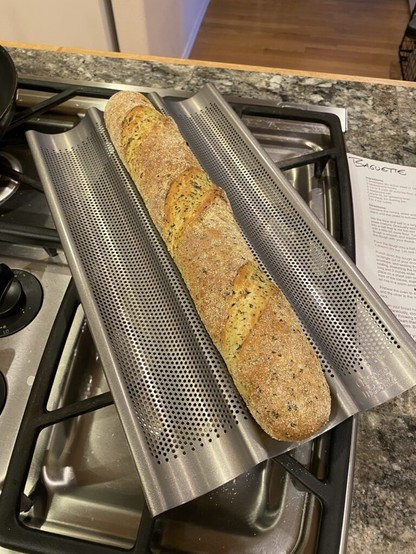making the bagel dough balls for the second rise
Okay, so I didn’t describe making the bagel dough rounds so they’re smooth and easy to make into nice even bagels in my very detailed bagel recipe. In fact, I’ve basically never shown it before at all, and people want to know. So let’s do that.
This happens after the first rise, when the dough has been allowed to sit for an hour and have a nice long nap, growing rapidly under a towel. You’ll want to have already divided the dough into eight equal-weight lumps, as per the written recipe above, and then you’re ready to make those lumps nice and smooth.
First, grab one of your dough lumps, and find the smoothest part of it. Put that side down into your palm.
Put your thumb in the middle on the rough side, and pull all the edges around your thumb up. The smooth end will stretch, and get even smoother, when you do this. It’ll look kind of like an opening xenomorph egg but will not – I stress will NOT – eat your face, or implant any eggs in your body.
Then press all those high bits together and then down into the centre of the ball, pinching all the seams together. You’re closing the xenomorph egg back up, which is why it will not eat you. And also how it’ll get smooth all over.
You’ll want to repeat this a couple of times. Each time the smooth side will stretch more and get smoother, and the rough side will improve as well. Make sure that you’re pulling all the side bits together in the centre; don’t leave any sticking out, and pinch closed all the seams.
After a couple of goes at this, you’ll end up with a nice fairly-smooth rough side, and a very smooth smooth side. Here’s a good “rough” side; you can see that really, it’s fairly smooth, other than one tab towards the bottom that still needs to be pulled in:
Once you’re satisfied, you can smoosh the entire ball down a little on your kneading surface – whatever that happens to be – rough side down. Roll it a little, to help the dough bind to itself. Then put it on your parchment paper baking sheet, again with the rough side down to let it proof. As it rises for the second time, it’ll smooth the bottom out even more.
If it’s not perfectly smooth after all this, it’s still fine. When you go to boil, boil with the rough side up first, then flip over to boil with smooth side up. Then put it back on the baking tray, keeping the smooth side up for baking.
I know this sounds a little like keeping good side/bad side straight when sewing, but… it should make sense when you do it, and it’s easier than sewing, since there’s no “oops, I forgot this turns inside out” to get wrong.
After the proofing is done, then with a little bagel fingering to put in holes, we’re ready to go into the water!
To get the bagels into the water, use a hurricane or a well-perforated giant spoon or whatever you have. Believe me, this is way easier than doing it by hand, and also helps preserve the shape.
The bagel in the hurricane in this photo is rough-side up; the bagel still on the sheet is smooth-side up. You can still see a difference but it’s really negligible.
All of the bagels in the next photo are just into the water with rough sides up, set to boil for two minutes. As you can see, this side is still less smooth than the smooth sides! But these are well into “no one will notice or care” territory, and again: it’s fine. Boil them for two minutes, flip with the hurricane, boil for two minutes more.
(Or boil for less time for a less chewy bagel, just make sure the boiling time is the same on boths ides.)
Boiling is a good time to oil the empty side of your baking tray, so take care of that at the same time.
After the second boil, just lift out with your hurricane and place the bagels back on your now-oiled baking tray. They’ll shrink and wrinkle some before going into the oven, that’s fine; they’ll expand back out in the oven. This is, as per the recipe, when you do any toppings.
See? This bagel got wrinkly. I don’t know why. They all do it to some degree, but despite all having the same amount of dough (within one gram) they’ll shrink differently. But it doesn’t matter, they’ll come out fine:
Also, while this is a bit out of scope for this how-to on smoothing your bagels, you’ll want to apply the egg wash to as much of the bagel as possible. For me, that means making sure the sides and the walls of the hole are coated, down to the parchment paper. But don’t let egg pool up and form puddles – or if that happens, make sure you tear it off before serving or putting the bagels away. Again, they’ll be fine.
Like so! All baked, out of the oven, and onto cooling racks, expanded nicely back out with no wrinkles.
Here’s what a random bagel bottom looks like, this one still very hot ow ow ow ow ow ow ow
They’re a bit soft, still, at this point, so it really is best to let them cool at least a bit before eating.
Enjoy your #bagels !
[link] #HomeEc #bagels #baking #HomeEc






